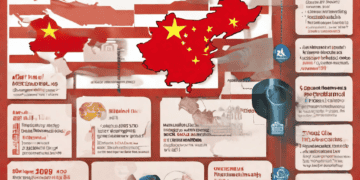Two decades following China’s entrance into the World Trade Organization (WTO), significant shifts in the global economic landscape have occurred. The convergence of historical events in December 2001 marked a turning point as China joined the WTO just days before the United States and allies secured a milestone victory in Kandahar against the Taliban, initiating a two-decade military engagement in the Middle East that carried substantial costs for the superpower in terms of resources and international goodwill.
China’s accession to the WTO precipitated transformative effects on the global economy. Over the past twenty years, more than 500 million Chinese citizens have risen out of poverty, propelling China to become the largest economy in terms of purchasing power parity and the second-largest in market exchange rates. Additionally, it has emerged as the world’s foremost trading nation, significantly impacting global manufacturing and resource consumption.
This substantial structural evolution has brought about disruptions, affecting countries differently based on their market flexibility, social safety nets, and growth patterns. While some nations experienced positive outcomes from economic integration with China, others, like the United States, encountered challenges due to stagnant middle-class incomes and a lack of adequate safety nets.
Countries in Southeast Asia, initially concerned about competing directly with China, found sustained improvements in living standards through increased economic ties and supply chain specialization. However, China’s transition from the world’s factory to a significant consumption market, marked by a burgeoning middle class, is currently causing disruptions in the global economy.
Despite the considerable benefits, China’s economic growth has imposed pressure on the global system, revealing gaps in global institutions’ ability to adapt to these shifts. For instance, the WTO’s rulemaking hasn’t kept pace with modern commerce, leading to tensions between China and several Western nations over compliance.
Arguments highlighting China’s adherence to WTO protocols and domestic reforms are surfacing, suggesting that fault lies not solely with China but also with the United States, which has opted out of adhering to established WTO rules and has pursued unilateral trade measures. The subsequent trade coercion between the US and China, and China’s similar actions against countries like Australia and Lithuania, have further strained the global trading system.
Addressing these challenges requires a transformation from zero-sum strategic competition between major powers into positive-sum economic competition through multilateral rules safeguarding global trade. This shift demands the development of new multilateral rules and economic integration, curbing the misuse of economic power for political ends.
China’s potential entry into the Comprehensive and Progressive Agreement for Trans-Pacific Partnership (CPTPP) may signify a willingness to adopt stringent regulations concerning state-owned enterprises, data barriers, and labor standards, aligning with its reform agenda. However, it necessitates China’s abandonment of coercive trade practices, particularly towards Australia, to gain acceptance.
The US is urged to refocus on strengthening the multilateral system, investing in domestic institutions to distribute gains from trade more equitably and lessening its exclusive focus on countering China. This shift requires the US to lead in multilateral institution reform rather than retreat into exclusive groupings.
Expectations from China include embracing WTO reform, abstaining from economic coercion for political control, moving away from managed trade with the US, and engaging in building a multilateral digital trade regime to restore confidence in its leadership within the global economic community.
Breaking supply chain news is just a click away at The Supply Chain Report. Enhance your knowledge of international trade at ADAMftd.com with free tools.
#ChinaWTO20Years #GlobalTradeDynamics #EconomicShifts #WTOReform #USChinaRelations #GlobalSupplyChain #EconomicIntegration #TradeCoercion #Multilateralism #CPTPP #ChinaGrowthStory #GlobalEconomicPolicy

















